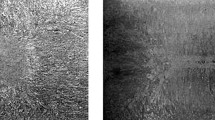Conclusions
Quenching the specimens from 800°C does not lead to the redistribution of the carbide in the volume of the alloys of the iron-cast iron system. The most homogeneous structure of the alloys is formed only in quenching from 900°C. However, quenching from 1000°C increases the size of voids and causes supinating of the alloys, although their homogeneity increases.
Heat treatment increases the tensile strength of the alloys which contain 10–50% of low-alloy cast iron. The alloys quenched from 800°C have the maximum strength after tempering of 300°C, whereas the alloys quenched from 900 and 1000°C with a maximum strength at tempering temperatures of 250 and 200°C, respectively.
The highest hardness was recorded for the alloys after quenching from 900°C. All the alloys quenched from 800, 900, and 1000°C are characterized by sufficiently higher hardenability to a depth of 4mm.
An increase of the tempering temperature of the alloys in the range 200–300°C reduces their impact toughness. This fact is not in agreement with the generally recognized interpretations. However, an increase of the cast iron content usually greatly reduces the KC value of the specimens, regardless of the quenching and tempering temperatures.
Similar content being viewed by others
Literature cited
A. T. Mamedov and A. A. Guliev, “Production of powders from cast iron shavings and special features of manufacture of components from them. II. Special features of reducing powder components, their structure and properties,” Poroshk. Metall., No. 9, 4–10 (1988).
V. N. Antsiferov and L. M. Grevnov, “Some special features of tempering powder steels,” Poroshk. Metall., No. 9, 47–52 (1987).
A. P. Guliev, Physical Metallurgy, 6th Edition, Revised and Supplemented [in Russian], Metallurgiya, Moscow (1986).
C. Crussard, “Electronen mikroskopie,” Neue Huette, 3 No. 7, 53–66 (1962).
Author information
Authors and Affiliations
Additional information
Translated from Poroshkovaya Metallurgiya, No. 1(325), pp. 47–53, January, 1990.
Rights and permissions
About this article
Cite this article
Mamedov, A.T., Guliev, A.A. Production of powders of cast iron shavings and special features of production of components from these powders. III. Structure and strength of heat-treated alloys. Powder Metall Met Ceram 29, 42–46 (1990). https://doi.org/10.1007/BF00796092
Received:
Issue Date:
DOI: https://doi.org/10.1007/BF00796092




